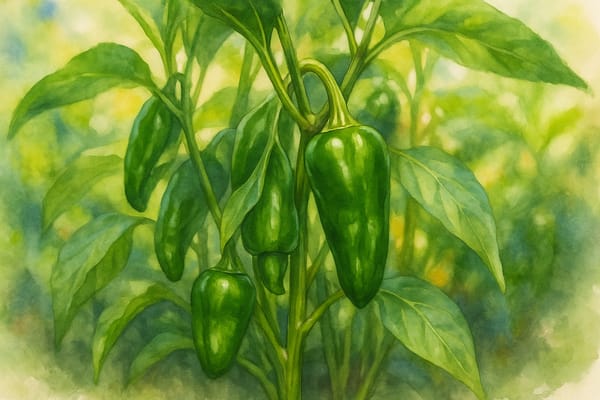There’s something irresistible about the ritual of picking a handful of green Padron peppers — still warm from the sun — and tossing them into a pan with a swirl of olive oil. The skins blister and pop. A sprinkle of sea salt, and you’ve got summer on a plate. These small, crinkled chillies from Galicia have become a favourite for gardeners seeking both flavour and fun — and here in Cornwall, with its sheltered microclimates and sea-warmed walls, they grow surprisingly well.
Starting from Seed: The Quiet Promise of January
Padron peppers are best started early — from January through to April — when the garden is still quiet and the light just begins to return. Sow the seeds 0.5cm deep in trays or pots filled with moist, good-quality compost. A heated propagator or warm windowsill (18–25°C) works wonders, and if you can stretch to a heat mat, it’ll speed germination, which can take between one and three weeks.
The first green loops of growth feel almost tropical in the gloom of winter. Once they’ve developed a pair of true leaves, move the seedlings into their own pots and keep them growing steadily in bright, warm conditions.
Growing On: Patience, Warmth, and a Watchful Eye
Padron peppers are not fans of the cold. These are plants of Spanish sunshine and long summer days — so patience is key. Don’t even think of planting them out until all risk of frost has passed and nights remain reliably above 12°C. In Cornwall, that’s usually late May or even June, unless you’re growing under glass.
If you have a greenhouse or polytunnel, you’ll be rewarded with earlier fruit, more consistent crops, and happier plants overall. But for those without, a sunny, sheltered wall — especially south-facing — can work almost as well. The warmth reflected from stone or brick creates a microclimate that peppers adore. Raised beds or generous pots (20–30cm wide) on patios work beautifully too, especially if you’re able to move them to follow the sun.
Give each plant around 30–45cm of space and sink a bamboo cane beside it at planting time — these little plants are stronger than they look, but once the fruit comes, they’ll need support. The soil should be fertile, free-draining, and rich in organic matter. Mulch to conserve moisture, and water steadily through dry spells. These plants dislike extremes: don’t let them dry out, but don’t leave them waterlogged either.
Feeding and Flowering: Preparing for the Crop
As soon as flowers start to appear, begin a fortnightly feed with high-potash liquid fertiliser — tomato food works well. Avoid nitrogen-rich feeds, which give lush leaves at the expense of fruit.
Pinching out the growing tip once the plant reaches 20cm tall encourages bushiness and better yields. Tie stems gently to their supports as they climb and branch.
Harvest Time: Tapas in the Garden
The first harvest often arrives in July, though earlier if grown under cover. Pick Padron peppers when they are still young — about 5–6cm long — for that traditional mild, nutty flavour. Left to grow larger, they can develop more heat. And therein lies the joy: most are gentle, but one in every ten (so they say) carries a surprising kick.
Harvesting little and often not only keeps your kitchen well-stocked, but encourages more fruit to form. The plants will continue cropping until autumn if well cared for.
Common Challenges: A Gardener’s Watchlist
- Aphids and red spider mites can be a nuisance, especially under glass. Keep air moving, check the undersides of leaves regularly, and introduce companion plants like marigolds to attract beneficial predators.
- Blossom end rot signals irregular watering or calcium deficiency — consistent moisture is key.
- If your plants flower but don’t fruit, it’s likely too cold, too shady, or lacking in pollinators. A gentle shake of the plant or hand pollination with a brush can help.
The Role of Place: Why Cornish Gardeners Can Succeed
Cornwall’s coastal location offers some unexpected advantages. Even without a greenhouse, many gardeners have access to sheltered courtyards, protected walled gardens, or patios that capture and hold heat. South-facing locations are golden — literally. The added warmth and sunlight help push these Mediterranean plants toward successful fruiting.
Compared to exposed or windy plots, even small adjustments in planting position can double your success. Consider using cloches or mini poly tunnels early in the season to warm the soil and shelter young plants. In containers, mobility is your friend — move pots around to catch the best light, or bring them indoors during sudden cold spells.
Final Thoughts: Growing a Taste of Spain in the West
Padron peppers are generous plants. Give them warmth, steady care, and good soil, and they’ll give you weeks of delicious green fruit — ideal for evening nibbles or late-summer garden feasts. Their compact size, handsome foliage, and culinary value make them an excellent choice for Cornish gardens, whether you grow in a greenhouse, against a sunny wall, or in a container by the kitchen door.
They remind us that even in cooler corners of the UK, with care and timing, it’s possible to grow a little bit of the Mediterranean — and to share it, blistered and salted, with those you love.











